The Actual Number of Chinese Visitors to Europe May Be Surprisingly Low
Tourism statistics – EU and China
China was the 8th most popular non-EU destination for EU residents in 2016.
Over the last 10 years, the number of nights spent in the EU by tourists from China more than tripled, reaching nearly 25 million nights in 2016.
Nights spent by Chinese tourists of the total nights spent by guests from outside the EU, 2016 (%)
- Source: Eurostat (tour_occ_ninraw)
On 12 July 2016 the President of the European Commission, Jean-Claude Juncker, and the Chinese Prime Minister, Li Keqiang, announced that 2018 will be the EU-China Tourism Year (ECTY). This initiative provides ‘a unique opportunity to increase visitors’ flows and investments on both sides’ (Elżbieta Bieńkowska, European Commissioner responsible for tourism — ‘European Tourism Forum’ in Bratislava on 11 October 2016).
This article takes a look at tourism flows between the European Union (EU) and China. The first section focuses on visits to Asia, and in particular China, made by EU residents. The second looks at visits made by Chinese residents to the EU using accommodation statistics (nights spent in rented tourist accommodation).
Asia is the second most visited destination outside Europe for EU residents
Europe — and very often a tourist’s own country of residence — remained the most attractive destination for most trips made by Europeans. It accounted for 86.0 % of the total number of trips made in 2016 (see Figure 1). The top continent visited outside Europe was America with 5.7 % of total trips, followed by Asia with 4.9 %.
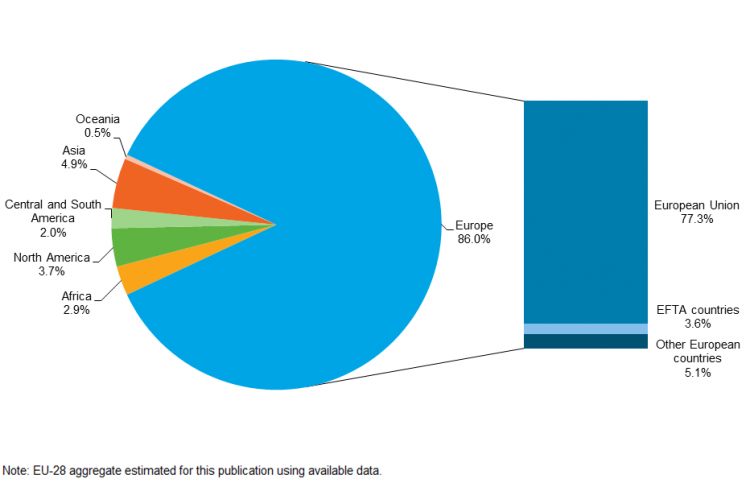
Figure 2 takes a closer look at trips made outside the EU. Trips to other destinations in Europe — such as Turkey, Switzerland, Norway, Russia and all other non-EU European countries — made up the largest share (38 %). Nonetheless Asia accounted for more than one in five trips outside the EU (22 %). When measured in terms of nights spent and expenditure, Asia’s share of all non-EU tourism increases to 29 % and 28 % respectively. EU residents made 15.2 million trips to Asia — representing a total of 263.5 million nights — and spent EUR 25.5 billion on those trips. A part of the EUR 25.5 billion spent stayed within the EU economy, for instance for intercontinental flights operated by European airlines or commission fees charged by European travel agencies.
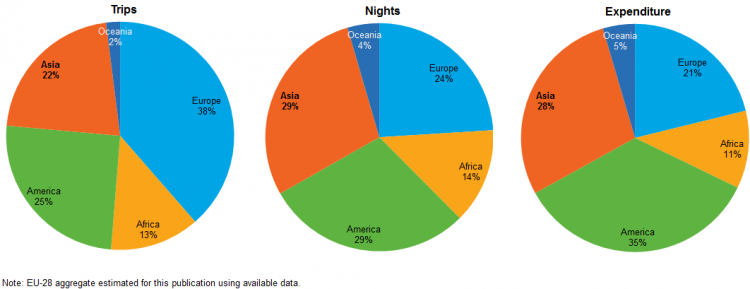
Figure 2: Trips, nights spent and expenditure of EU residents outside EU-28, by destination, EU-28, 2016 (%)
Source: Eurostat (tour_dem_ttw), (tour_dem_tnw), (tour_dem_extotw)
China is the 8 th most popular non-EU destination for EU residents
China is becoming a popular travel destination for Europeans. In 2016, China ranked number 8 among non-EU destinations (see Figure 3 and Table 1). The United States was the most popular non-EU destination, followed by countries neighbouring the EU (Turkey, Switzerland, Norway and Russia).
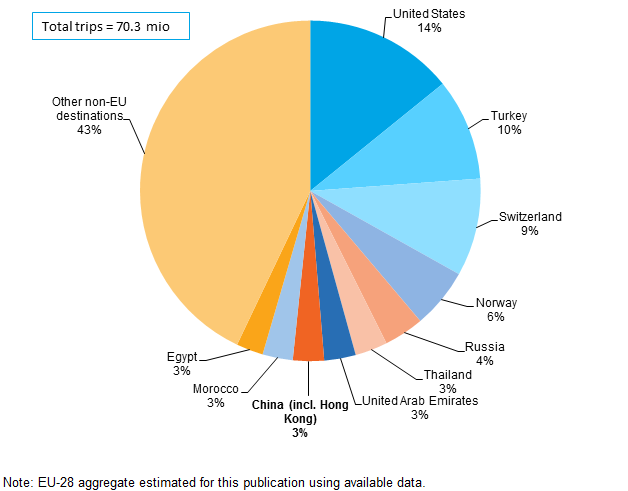
Figure 3: Top-10 non-EU destinations for tourism trips of EU residents, EU-28, 2016 (%)
Source: Eurostat (tour_dem_ttw)

Table 1: Top 10 non-EU destinations for trips of EU residents, EU-28, 2016
Source: Eurostat (tour_dem_ttw), (tour_dem_tnw), (tour_dem_extotw)
Two Asian countries — Thailand and the United Arab Emirates (each of them representing just above 3.0% of EU residents’ trips to non-EU destinations) — were still slightly ahead of China (3.0 %) in 2016. EU residents made 2.1 million trips to China in 2016, and stayed on average 15.6 nights. Total spending on trips with China as main destination was EUR 5.1 billion (China climbed to third place in expenditure terms — see Table 1).
In the five year period 2012—2016, the number of trips by EU residents to China increased by 16 % (data based on 20 countries, which account for 76 % of the trips made by EU residents).
Tourism from China to the EU has tripled in ten years
The number of nights spent in the EU by tourists from China has more than tripled over the last ten years, reaching nearly 25 million nights in 2016. Tourism from China has risen more than that from other major non-EU countries such as the United States, Russia or Brazil (see Figure 4).

Figure 4: Growth of tourism nights spent in EU tourist accommodation, 2016 compared with 2006 – Selected origin countries (%)
Source: Eurostat (tour_occ_ninraw)
Figure 5 shows that the overwhelming majority of foreigners staying in tourist accommodation establishments in EU countries came from other EU countries (72 %) or other European countries (9 %). Of non- European tourists, those from Asia accounted for the biggest share of nights spent (8 %).

Figure 5: Nights spent by non-residents in tourist accommodation establishments by world region of the guest, EU-28, 2016 (%)
Source: Eurostat (tour_occ_ninraw)
1.7 % of all nights spent in EU-28 countries by non-residents was by tourists from China; for Finland the share was nearly 5 % (see Figure 6).
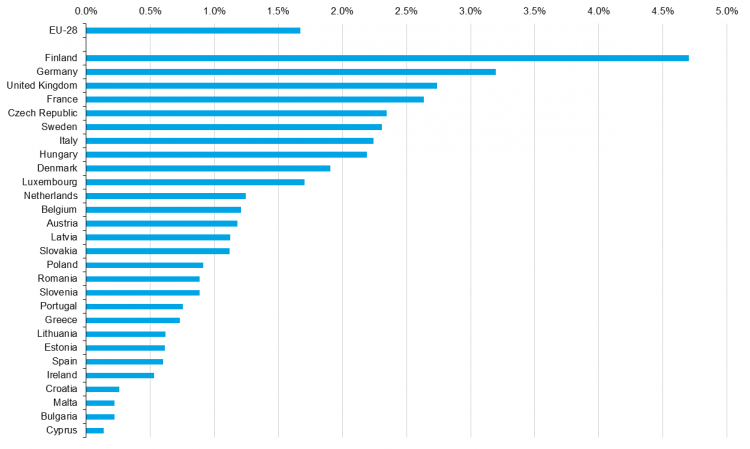
Figure 6: Nights spent by Chinese tourists of the total nights spent by non-residents, 2016 (%)
Source: Eurostat (tour_occ_ninraw)
The share of Chinese tourists out of the total nights spent by tourists coming from outside the EU was almost 6 % (see Figure 7). Luxembourg was very popular among Chinese tourists; 1 in 8 nights spent by non-EU tourists in Luxembourg, was spent by a Chinese tourist.
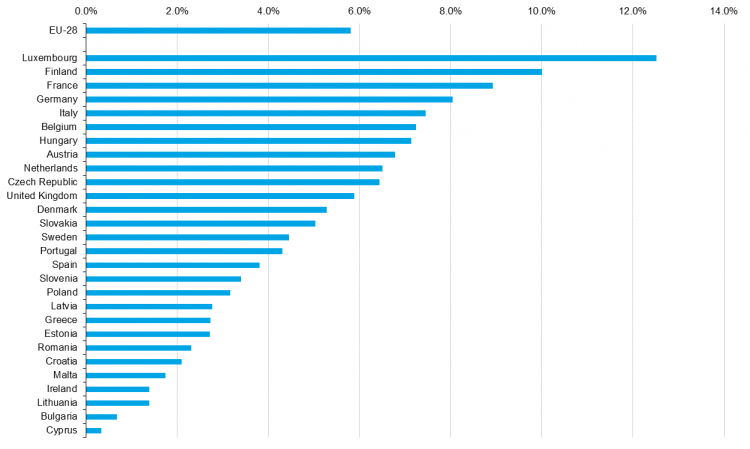
Figure 7: Nights spent by Chinese tourists of the total nights spent by guests from outside the EU, 2016 (%)
Source: Eurostat (tour_occ_ninraw)
Tourists from China mainly stayed in just four EU countries: more than 7 out of 10 overnight stays by tourists from China to the EU were in the United Kingdom (31 %), Italy (18 %), France (13 %) and Germany (10 %) (see Figure 8).
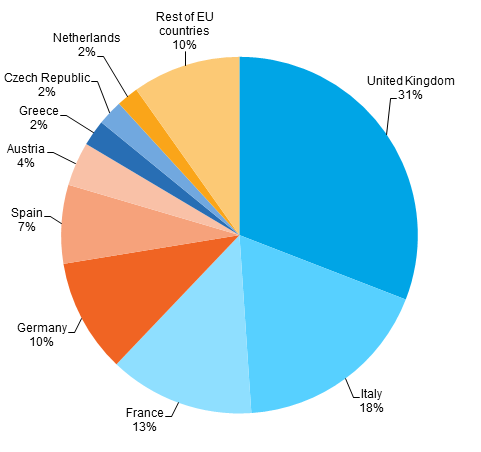
Figure 8: Tourism nights spent by residents of China in EU-28, 2016 (%)
Source: Eurostat (tour_occ_ninraw)
The EU is a net exporter of travel services to China
In 2016, the EU exported travel services valued at nearly EUR 7 billion [1] . In the same year, the EU imported nearly EUR 3 billion from China (i.e. Europeans’ spending on trips in China). Europe was a net exporter of travel services with a positive balance of EUR 4 billion.
Until 2008 (see Figure 9) the travel item showed a negative balance in the EU’s balance of payments with China, with debits exceeding credits.

Figure 9: EU-28 balance of payments with China, travel item, 2004-2016 (mio euro)
Source: Eurostat (bop_eu6_q)
The growth rates of the monetary flows (credits and debits) were in line with the underlying physical flows of Chinese tourists staying in European accommodation and EU tourists making trips to China respectively (see above).
Source data for tables and graphs
Data sources
This article is an analysis of harmonised data collected by the Member States in the frame of the Regulation (EU) No 692/2011 of the European Parliament and of the Council concerning European statistics on tourism.
Tourism, in a statistical context, refers to the activity of visitors taking a trip to a destination outside their usual environment, for less than a year. It can be for any main purpose, including business, leisure or other personal reasons other than to be employed by a resident person, household or enterprise in the place visited.
Tourism statistics in the EU consist of two main components: on the one hand, statistics relating to capacity and occupancy of collective tourist accommodation; on the other, statistics relating to tourism demand. In most EU Member States, the former are collected via surveys filled in by accommodation establishments, while the latter are mainly collected via traveller surveys at border crossings or through household surveys.
Context
EU-China Tourism Year (ECTY) was launched in Venice on 19 January 2018. This initiative, agreed at the 2017 EU China Summit, aims at supporting the development of new and better travel itineraries, promoting inter-cultural understanding, and enhancing travel and tourism experiences, including greater promotion and more sustainable tourism.
According to a United Nations World Tourism Organisation (UNWTO) publication titled ‘Tourism highlights’, the EU is a major tourist destination, with five of its Member States among the world’s top 10 destinations in 2016. According to this publication, China continues to consolidate its position as the world’s largest travel market in terms of both outbound travel and expenditure.
Tourism has the potential to contribute towards employment and economic growth, as well as to development in rural, peripheral or less-developed areas. These characteristics drive the demand for reliable and harmonised statistics within this field, as well as within the wider context of regional policy and sustainable development policy areas.
Tourism can play a significant role in the development of European regions. Infrastructure created for tourism purposes contributes to local development, while jobs that are created or maintained can help counteract industrial or rural decline. Sustainable tourism involves the preservation and enhancement of cultural and natural heritage, ranging from the arts to local gastronomy or the preservation of biodiversity.
The Actual Number of Chinese Visitors to Europe May Be Surprisingly Low

This story tries to get to the bottom of a mystery: How many Chinese tourists visit Europe each year? The real answer is elusive.
2018 marks the China-EU Tourism Year, a European Union-funded project aimed at promoting travel and cultural exchange between EU member states and China. The designated tourism year is very much the European Commission’s response to the growing number of Chinese travelers who visit Europe and constitute an increasingly important source of revenue across EU member states.
Just how important? Anecdotally, Chinese travelers are the by far most important group of travelers in Europe, and there’s a whole industry that aims to support businesses in catering to this group of travelers. In reality, Europe has a long way to go to catch up with the competition and is arguably the continent that performs the worst relative to its geographic position, cultural assets, and connections to China.
Let’s start with the basics: how many Chinese travelers visit Europe each year? According to one (state-funded) Chinese source, some 5.5 million Chinese travelers were projected to visit Europe in 2017. According to documents put forward by the China-EU Tourism Year, 12 million Chinese tourists visited Europe back in 2015. Did Chinese tourist numbers in Europe drop from 12 million in 2015 to 5.5 million in 2017? According to the State Council of the People’s Republic of China, tourists actually grew by 65 percent year-over-year in the first half of 2017. The numbers simply don’t add up.
The Numbers Simply Don’t Add Up
Given the extreme fluctuations pointed out above as well as the, reportedly, vital importance of Chinese tourist spending, one would imagine that a humble luxury retailer in Paris goes from boom year to bankruptcy in the span of a couple of years—or that Europe-bound flights sometimes depart China without passengers, and at other times are horribly overbooked.
The news on the ground is that, well, businesses that cater to Chinese travelers aren’t facing a business environment akin to a cryptocurrency rollercoaster ride— things are pretty stable. European airlines are also reasonably good at predicting Chinese demand and respond to it—that is, as far as the China’s aerospace authorities grant them takeoff and landing slots at Chinese airports.
The real story is, of course, that no one seems to know how many Chinese tourists visit Europe each year. That’s a problem. If the European Union decided to spend tens or perhaps hundreds of millions of tax-payer Euros under the impression that it is the recipient of 12 million Chinese tourists as early as in 2015, that’s an even bigger problem.
No One Seems to Know How Many Chinese Tourists Visit Europe Each Year
Even the humble European retailer or tour operator may have a better grasp on where the Chinese tourism market is going than big stakeholders such as the European Union and the Chinese government. A cynic may argue that the latter has good reasons to overstate the importance of its tourists, yet it’s the former which appears to overstate arrivals by the highest order of magnitude.
Or understate? How many Chinese travelers actually visit Europe each year?
Ironically, we can go to the European Union for what by all accounts are quite reliable figures on Chinese arrivals in Europe. The European Commission, which collects and publishes data on visa applications at all Schengen member’s visa application centers (e.g., embassies, consulates, purpose-built visa application centers), more or less has the full story. According to its most recent statistics, 2,110,103 Schengen visas were issued to Chinese nationals in 2016—visas that cover all EU territory with the exceptions of the United Kingdom, Ireland, Bulgaria, Croatia, Cyprus, and Romania—but also including non-EU members Norway, Iceland, Liechtenstein, and Switzerland.
The European Union Has Good Data on Chinese Tourist Arrivals, but Promotes Numbers Off by a Factor of Four
Unfortunately, things aren’t as easy as putting 2,110,103 as the exact number of Chinese visitors to Europe, but it takes us far closer to the truth than any “estimate” or “projection” made by stakeholders that really should know a whole lot better. In reality, some of these visas remain unused, and others are used for repeat visits to Europe. Most likely, the actual number of “arrivals” to European Union countries is somewhat higher than 2.1 million on account of multiple entry visas, but we’re still only talking about 2.1 million Chinese individuals.
To put things in perspective, the United States issued 1,991,647 non-immigration visas to Chinese nationals in 2016, a destination substantially smaller in terms of population. This number of visas issued generated 2.97 million Chinese visits throughout the year. Assuming that the same relationship between visas issued and visits recorded holds for the European Union, Schengen Area countries generated around 3.1 million Chinese visits in 2016. Adding UK arrivals to the mix, we end up at around 3.3 million arrivals—and that’s assuming that European countries attract as many repeat visitors as the United States, which has a much larger Chinese diaspora and Chinese student population.
The United States Is Doing Better Than Europe, and Its Arrival Numbers Aren’t Misleading
The source of the wildly different arrival numbers presented for Europe rests on counting practices. In most European countries, a Chinese tourist who crosses the border from another European country (and stays for at least one night) is counted as an arrival. The very same tourist is also counted as an arrival at the country where they entered Schengen, as well as in all other European countries where they spend a night or more throughout their visit. For travelers in tour groups who are bused between European countries, this often means that each traveler is counted as arrivals a handful of times if not more. Consequentially, a tour group of, for example, 20 Chinese travelers, may end up recorded as 100 or more “arrivals” to the continent.
The result is highly confusing numbers that even the European Union doesn’t get right. Or perhaps, in this case, uses to its advantage to create a narrative that is detached from reality but furthers political goals. It doesn’t mean these figures are necessarily wrong, but they’re certainly misleading.
If the United States Counted Tourists the Same Way, It Would Claim Over 10 Million Chinese Arrivals
If the United States counted tourists in the same way, i.e., not at their first immigration checkpoint but once every time they cross state lines, then the United States would look even further ahead of Europe than it already is in terms of Chinese arrival numbers.
There’s always been a lot of talk about China’s government publishing inaccurate numbers and data to further its political goals. The European Union, at taxpayers’ expense, doing the very same thing to inflate China’s tourism influence over Europe—and consequentially misleading European businesses—isn’t a whole lot better. And while European businesses may never have trusted GDP numbers or other statistics published by China, this isn’t the kind of skepticism stakeholders are used to employing when dealing with the European Union.
Besides, if the China-EU Year of Tourism is measured against the 12 million Chinese arrivals that supposedly happened in 2015, it’ll look like a spectacular failure. Nobody wants that, so it’s time to get real about Chinese influence over European tourism. 3.3 million visitors from a tourism market that barely existed 10 years ago leaves more than enough business opportunities for Europe.
This story originally appeared on Jing Travel, a Skift content partner.
The truth about Chinese travellers

C hinese tourists are among the world’s most maligned. But they also spend $300 billion abroad each year, making them a force too important to ignore.
Mainland Chinese citizens made 136.8 million trips across their borders in 2016 (according to China Outbound Tourism Research Institute) – a 2.7 per cent year-over-year rise. And, in a significant shift from previous years, fewer than half of those trips were to “Greater China” – ie Hong Kong, Macau or Taiwan.
More than 70 million trips were to other destinations – an 11.7 per cent increase from 2015.
That’s roughly the same as the number of Americans (66 million) who travelled internationally in 2016. But here’s a difference: the Chinese are spending far more than anyone else.
Chinese tourists spent $292 billion (£224 billion) abroad in 2015, nearly three times as much as the second biggest spenders, the Americans, and nearly five times as much as Britons abroad. These are the most recent statistics available from the World Tourism Organisation, which has predicted a 14 per cent rise in Chinese spending in 2016.
Where they go
The Chinese name for China is 中国, pronounced “Zhōngguó” in Mandarin, and it translates literally as “The Middle Kingdom”; for centuries China expected people to come to it.
Pair that philosophy with half a century of isolation under the Communist Party, add into the mix the frustratingly difficult process of applying for foreign visas and the relatively recent emergence of China’s middle class, and it’s hardly surprising that, traditionally, Chinese have headed to domestic destinations for their holidays.
In fact, they’ve really only been travelling abroad for pleasure in significant numbers for the past two to three decades. (Europeans, of course, and more recently, Americans, have been trotting around the globe helping themselves for rather longer… making their bad behaviour, perhaps, more inexcusable.)
Domestic tourism has increased 10 per cent annually over recent years – and contributes to an estimated four per cent of the country’s GDP.
Shanghai is a popular destination – but beware the crowds Credit : © Sean Pavone / Alamy/Sean Pavone / Alamy
Big cities – Beijing and Shanghai top the destination wishlist – see so many domestic tourists on even ordinary weekends that major shopping streets have one-way pavements, with police directing foot traffic.
Often domestic trips take patriotic inspiration: go to the Three Gorges Dam, a grim industrial site in one of the country’s poorest regions, for example, and it’s swarming with visitors.
On a recent trip, a Chinese guest asked whether I, an American, had visited my own country’s Hoover Dam. As I scrambled to remember exactly where in the US that nearly 100-year-old structure might be found, she recited comparative statistics on the two constructions.
That so many high-ranking cadres read engineering at university (these things matter: many Americans got law degrees; British politicians go for PPE) goes a long way to explaining why the Chinese dam was built (its productivity is hotly debated: the word on the street clashes dramatically with official statistics), and also why travel to see it has been so enthusiastically promoted.
The country’s wild south-west is often praised for being geographically and ideologically furthest away from the capital. Intrepid young people head to the mountainous Yunnan province, which borders Burma, Laos and Vietnam, and is one of the most ethnically diverse regions of the country.
The Yungang Grottoes are one of China’s 52 UNESCO World Heritage sites Credit : Credit: JTB MEDIA CREATION, Inc. / Alamy Stock Photo/JTB MEDIA CREATION, Inc. / Alamy Stock Photo
But whether you’ve opted for a jaunt up the holy Yellow Mountain in Anhui, or a pilgrimage to the monumental 5th century Buddhas at the Yungang grottoes near the northern city of Datong, as you take in these ancient sites of astounding beauty, one thing is for certain: you will not be alone.
Chinese visitors head to America in bigger numbers than tourists from any other country outside of North America Credit : This content is subject to copyright./WIN-Initiative
Isolation is not much of a goal when Chinese head abroad, either. Relatively nearby destinations – Vietnamese or Sri Lankan beaches, Japanese or Korean cities – are popular. American and Western European destinations are draws – China is behind only Mexico and Canada in the number of its nationals embarking on tourism in the US – and smaller European countries saw increased popularity over the past few years, according to COTRI. As in other markets, fears of terrorism seem to have stalled growth in Chinese tourism to Egypt and Turkey, and to parts of Western Europe.
What Chinese like to do
When Chinese tourists come to Europe, they’re determined to hit – and shop in – every major capital. From Big Ben in London to the vineyards of Bordeaux, for first-timers, especially, they’re actively pursuing the beaten track.
Chinese head to Europe for culture – and shopping the big brands Credit : © 2012 Cyrielle Beaubois/? Cyrielle Beaubois
This is not a backpacking people: the young nouveau riche kids you’ll find in Canada, the US and Europe aren’t too bothered by exploring; more cultured students are working round-the-clock to be accepted in foreign MA and PhD programmes. Roughing it is not an aspiration for anyone.
Middle class Chinese often travel in groups, and coaches are a frequent feature, along with their umbrella-wielding Chinese guides. On these tours, they’re after a whirlwind of culture and history – it would not be unprecedented to visit 10 European countries in a fortnight.
Cynical young Chinese will scornfully tell you that the travelling middle classes pay lip service to appreciating culture, but they are mainly after the goods: specifically, European brands they can buy in situ, and bring home to lord over their non-travelling neighbours (this may go some way to explaining the extraordinary spending figures).
If you like neither sunning nor swimming, the Maldives may not be the best destination for you Credit : Credit: Ian Trower / Alamy Stock Photo/Ian Trower / Alamy Stock Photo
Aspirational destinations include the Maldives – and hotels there have been scrambling to cater for China’s emergent upper-middle class – but the question of “What to do?” remains high on operators’ minds: Chinese visitors aren’t adept at the “flop” portion of fly-and-flop holidays, eschewing, as they do, sunbathing, and having a limited appetite for recreational swimming.
If it’s classed as “luxury”, you’re guaranteed to find some Chinese tourists, but spending patterns skew far more, hotels report, towards shopping than they do towards in-hotel spends; if Brazilian guests are willing to splash some cash in order to bring the party, and Americans tip with abandon, the Chinese are rather more modest in their outlay, reserving their money for hitting the shops.
How they behave
Chinese of all economic classes are adept at operating in crowds. But spatial awareness is not a strong suit. While queues are not a popular pastime at home, tourists may consider joining the funny foreign customs while abroad.
Still, the Chinese government was moved just four years ago, thanks to unflattering feedback, to issue unintentionally revelatory proclamations on what its citizens should and should not do while abroad, under the title of ‘Guide to Civilised Tourism and Travel’. Choice tips include:
- Don’t lie down in public
- Don’t cough, sneeze or pick your nose or teeth in front of others
- Don’t take a long time using public toilets.
What Chinese on holiday like to wear
China is vast and its population legion, and the gap between rich and poor is growing at an alarming rate; it would be foolish to generalise about the sartorial range on show.
Chinese in groups often wear US trucker-style hats or visors, proclaiming the name of their tour operator. There will often be impressive photographic equipment.
An alarming number of women on domestic trips will be wearing inappropriate shoes; it is typical, while climbing misty and muddy Buddhist mountains in Chinese provinces, to find women in elaborately shoulder-padded polyester dresses with ankle-high pop socks and high heels in even the warmest of conditions.
And, of course, you’ll see also the latest trends with designer labels aplenty on many international tourists.
Dining and drinking habits
French food has much in common with Chinese: both cuisines – regionally varied as they are – rely on sophisticated sauces to cover rather humble portions of meat and veg, the legacy of decades of austerity. (Britain, by contrast, was the land of plenty for many generations and, thus, has a relatively unsophisticated indigenous fare).
Still, habits of a lifetime are hard to break, and if you’re used to having noodle soup with vegetables for breakfast, cereal will disappoint.
However, increasing availability of international food in Chinese cities has made the country’s diners far more cosmopolitan and flexible in their eating habits. Just don’t demand heavy drinking (there’s a widespread alcohol intolerance) or major dairy consumption (ditto re: lactose intolerance).
How to get along with them
Do say: I know a great place to go shopping.
But don’t: Throw too many stones. Recently in Beijing a professional tour guide told me that the international destination he most wished to visit was England – so he could “appreciate the beauty of the river Rhine.” The Chinese sense of Western geography can be unpredictable. But before you judge, consider this: China has the second-most Unesco World Heritage sites of any country after Italy. Fifty-two in total. How many of those can you name?
Source https://ec.europa.eu/eurostat/statistics-explained/index.php/Tourism_statistics_-_EU_and_China
Source https://skift.com/2018/01/09/the-actual-number-of-chinese-visitors-to-europe-may-be-surprisingly-low/
Source https://www.telegraph.co.uk/travel/destinations/asia/china/how-chinese-tourists-travel-etiquette-and-money/